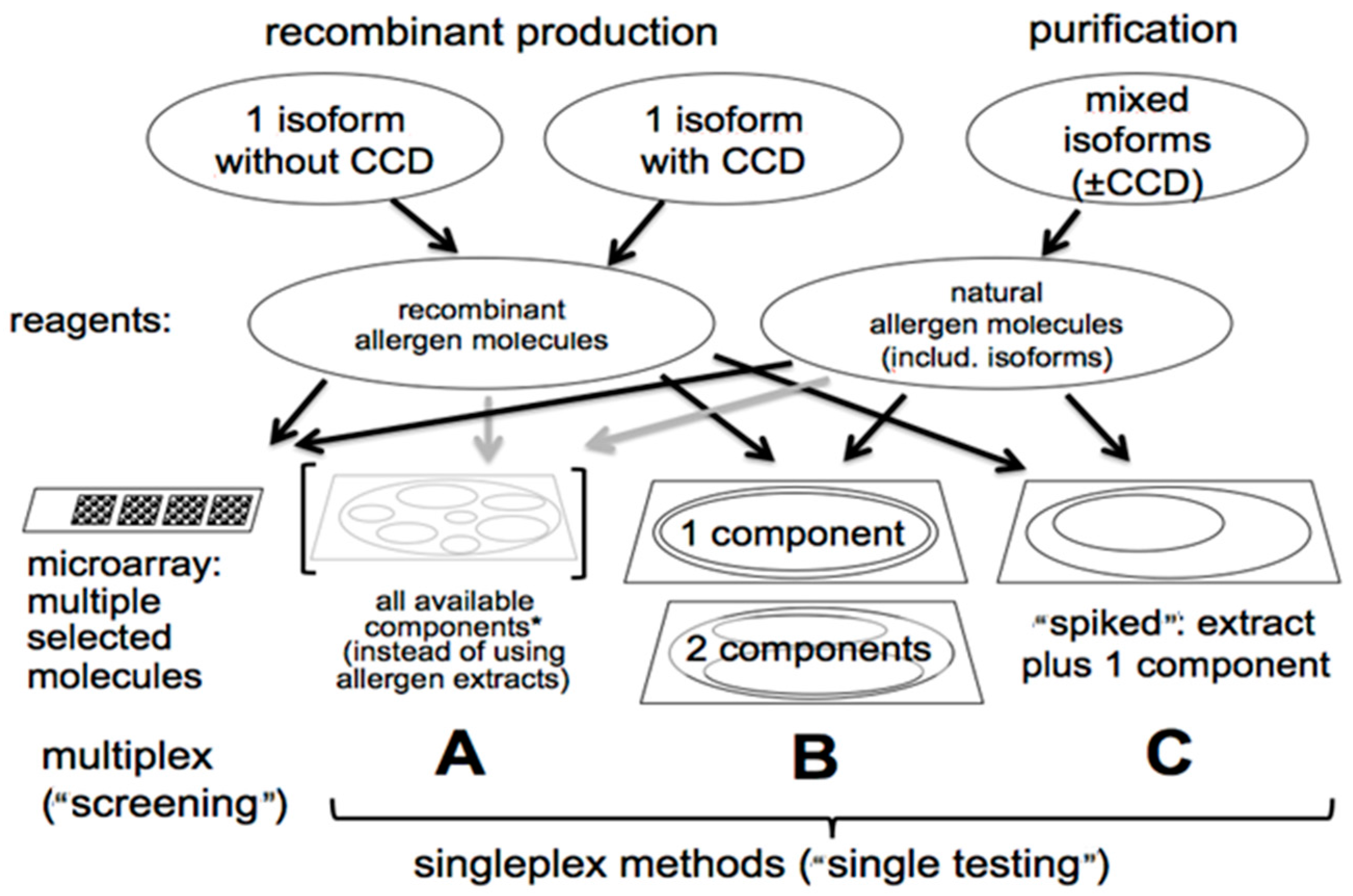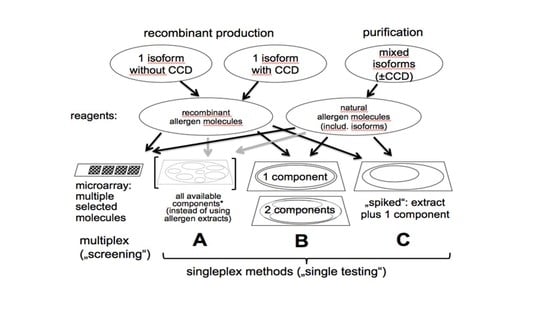Microarray Technology Applied to Human Allergic Disease
Abstract
:1. IgE and Allergic Disease
2. Detection of IgE Antibody in Serum
3. Technological Enhancements Leading to Microarrays
4. Advantages and Limitations of IgE Antibody Microarray Assays.
5. Alternative Microarray Assays for IgE Antibody
6. Concluding Thoughts
Conflicts of Interest
References
- Ishizaka, K.; Ishizaka, T. Physiochemical properties of reaginic antibody. I. Association of reaginic activity with an immunoglobulin other than gamma A or gamma G globulin. J. Allergy 1967, 37, 169–185. [Google Scholar] [CrossRef]
- Johansson, S.G.O. Raised levels of a new immunoglobulin class (IgND) in asthma. Lancet 1967, 2, 951–953. [Google Scholar] [CrossRef]
- Hamilton, R.G. Allergic sensitization is a key risk factor for but not synonymous with allergic disease. J. Allergy Clin. Immunol. 2014, 134, 360–361. [Google Scholar] [CrossRef] [PubMed]
- Homburger, H.A.; Hamilton, R.G. Allergic Diseases. Chapter 54. In Henry’s Clinical Diagnosis and Management by Laboratory Methods, 23rd ed.; Elsevier Health Sciences: New York, NY, USA, 2016. [Google Scholar]
- Wide, L.; Bennich, H.; Johansson, S.G.O. Diagnosis of allergy by an in vitro test for allergen specific IgE antibodies. Lancet 1967, 2, 1105–1107. [Google Scholar] [CrossRef]
- Thorpe, S.J.; Heath, A.; Fox, B.; Patel, D.; Egner, W. The 3rd International Standard for serum IgE: International collaborative study to evaluate a candidate preparation. Clin. Chem. Lab. Med. 2014, 52, 1283–1289. [Google Scholar] [CrossRef] [PubMed]
- Hamilton, R.G.; Matsson, P.N.J.; Adkinson, N.F.; Chan, S.; Hovanec-Burns, D.; Kleine-Tebbe, J.; Magnusson, C.; Renz, H.; Van Cleve, M. Analytical Performance Characteristics, Quality Assurance and Clinical Utility of Immunological Assays for Human Immunoglobulin E (IgE) Antibodies of Defined Allergen Specificities, Approved Guideline, 3rd ed.; Clinical Laboratory Standards Institute: Wayne, PA, USA, 2016. [Google Scholar]
- Hamilton, R.G.; Kleine-Tebbe, J. Methods for IgE antibody Testing: Singleplex and Multiplex Assays. Pediatr. Allergy Immunol. 2016, 27 (Suppl. S23), 1–250. [Google Scholar]
- Adkinson, N.F.; Hamilton, R.G. Clinical history driven diagnosis of allergic disease: Utilizing in vitro IgE testing. J. Allergy Clin. Immunol. Pract. 2015, 3, 871–876. [Google Scholar] [CrossRef] [PubMed]
- Hiller, R.; Laffer, S.; Harwanegg, C.; Huber, M.; Schmidt, W.M.; Twardosz, A.; Barletta, B.; Becker, W.M.; Blaser, K.; Breiteneder, H.; et al. Microarrayed allergen molecules: Diagnostic gatekeepers for allergy treatment. FASEB J. 2002, 16, 414–416. [Google Scholar] [CrossRef] [PubMed]
- Fedenko, E.; Elisyutina, O.; Shtyrbul, O.; Pampura, A.; Valenta, R.; Lupinek, C.; Khaitov, M. Microarray-based IgE serology improves management of severe atopic dermatitis in two children. Pediatr. Allergy Immunol. 2016, 27, 645–649. [Google Scholar] [CrossRef] [PubMed]
- Heaps, A.; Carter, S.; Selwood, C.; Moody, M.; Unsworth, J.; Deacock, S.; Sumar, N.; Bansal, A.; Hayman, G.; El-Shanawany, T.; et al. The utility of the ISAC allergen array in the investigation of idiopathic anaphylaxis. Clin. Exp. Immunol. 2014, 177, 483–490. [Google Scholar] [CrossRef] [PubMed]
- Patelis, A.; Gunnbjornsdottir, M.; Alving, K.; Borres, M.P.; Högman, M.; Janson, C.; Malinovschi, A. Allergen extract vs. component sensitization and airway inflammation, responsiveness and new-onset respiratory disease. Clin. Exp. Allergy 2016, 46, 730–740. [Google Scholar] [CrossRef] [PubMed]
- Sastre, J.; Landivar, M.E.; Ruiz-García, M.; Andregnette-Rosigno, M.V.; Mahillo, I. How molecular diagnosis can change allergen-specific immunotherapy prescription in a complex pollen area. Allergy 2012, 67, 709–711. [Google Scholar] [CrossRef] [PubMed]
- Canonica, G.W.; Ansotegui, I.J.; Pawankar, R.; Schmid-Grendelmeier, P.; van Hage, M.; Baena-Cagnani, C.E.; Melioli, G.; Nunes, C.; Passalacqua, G.; Rosenwasser, L.; et al. A WAO – ARIA - GA²LEN consensus document on molecular-based allergy diagnostics. World Allergy Organ. J. 2013, 6, 17. [Google Scholar] [CrossRef] [PubMed]
- Lupinek, C.; Wollmann, E.; Baar, A.; Banerjee, S.; Breiteneder, H.; Broecker, B.M. Advances in allergen-microarray technology for diagnosis and monitoring of allergy: The MeDALL allergen-chip. Methods 2014, 66, 106–119. [Google Scholar] [CrossRef] [PubMed]
- Wollmann, E.; Lupinek, C.; Kundi, M.; Selb, R.; Niederberger, V.; Valenta, R. Reduction in allergen-specific IgE binding as measured by microarray: A possible surrogate marker for effects of specific immunotherapy. J. Allergy Clin. Immunol. 2015, 136, 806–809. [Google Scholar] [CrossRef] [PubMed]
- Pascal, M.; Muñoz-Cano, R.; Reina, Z.; Palacín, A.; Vilella, R.; Picado, C.; Juan, M.; Sánchez-López, J.; Rueda, M.; Salcedo, G.; et al. Lipid transfer protein syndrome: Clinical pattern, cofactor effect and profile of molecular sensitization to plant-foods and pollens. Clin. Exp. Allergy 2012, 42, 1529–1539. [Google Scholar] [CrossRef] [PubMed]
- Williams, P.; Önell, A.; Baldracchini, F.; Hui, V.; Jolles, S.; El-Shanawany, T. Evaluation of a novel automated allergy microarray platform compared with three other allergy test methods. Clin. Exp. Immunol. 2016, 184, 1–10. [Google Scholar] [CrossRef] [PubMed]
- King, E.M.; Vailes, L.D.; Tsay, A.; Satinover, S.M.; Chapman, M.D. Simultaneous detection of total and allergen-specific IgE by using purified allergens in a fluorescent multiplex array. J. Allergy Clin. Immunol. 2007, 120, 1126–1131. [Google Scholar] [CrossRef] [PubMed]
- Renault, N.K.; Gaddipati, S.R.; Wulfert, F.; Falcone, F.H.; Mirotti, L.; Tighe, P.J.; Wright, V.; Alcocer, M.J. Multiple protein extract microarray for profiling human food specific immunoglobulins A, M, G, and E. J. Immunol. Methods 2011, 364, 21–32. [Google Scholar] [CrossRef] [PubMed]

© 2017 by the author. Licensee MDPI, Basel, Switzerland. This article is an open access article distributed under the terms and conditions of the Creative Commons Attribution (CC BY) license ( http://creativecommons.org/licenses/by/4.0/).
Share and Cite
Hamilton, R.G. Microarray Technology Applied to Human Allergic Disease. Microarrays 2017, 6, 3. https://doi.org/10.3390/microarrays6010003
Hamilton RG. Microarray Technology Applied to Human Allergic Disease. Microarrays. 2017; 6(1):3. https://doi.org/10.3390/microarrays6010003
Chicago/Turabian StyleHamilton, Robert G. 2017. "Microarray Technology Applied to Human Allergic Disease" Microarrays 6, no. 1: 3. https://doi.org/10.3390/microarrays6010003





